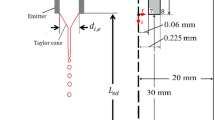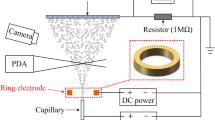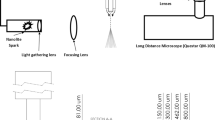Abstract
This article reports on a study into ambient gas's role in forming the electrospray cone-jet mode. The study aims to broaden the current knowledge, which is essentially confined to air as the surrounding medium in the electrospray process. This research is founded on a liquid-gas simulation, including fluid and electrostatic governing equations coupled with charge conservation and volume of fluid (VOF) interface tracking approaches. The application of various ambient gases, i.e., air, oxygen, nitrogen, methane, helium, and hydrogen, has a decisive impact on the cone-jet structure concerning geometrical profiles, which are mainly reflected in the dimensions of the whole cone-jet and the cone alone. The results indicated the altering effects of the ambient gas on equipotential configuration and charge density magnitudes. The flow patterns clarified the role of the gas type in streamlining and vortex creation within the fluid phases. Two validation tests were also performed to compare the simulation results with the experimental charged jet formation and the electrical variation of droplet mean diameter. The results displayed a good agreement supporting the aptness of the model developed.




















Similar content being viewed by others
Availability of data and materials
The data generated or analyzed during this study are included in the manuscript.
Abbreviations
- C :
-
Volume fraction
- Ca :
-
Capillary number
- D 32 :
-
Sauter mean diameter (μm)
- d i,e :
-
Emitter inner diameter (mm)
- d i,o :
-
Emitter outer diameter (mm)
- \(\overrightarrow{E}\) :
-
Electric field vector (Vm−1)
- E 0 :
-
Radial electric field (Vm−1)
- \({\overrightarrow{F}}_{\mathrm{ES}}\) :
-
Electric force vector (Nm−3)
- \({\overrightarrow{F}}_{\mathrm{ST}}\) :
-
Surface tension force vector (Nm−3)
- \(\overrightarrow{g}\) :
-
Gravity acceleration (ms−2)
- \(\overline{\overline{I}}\) :
-
Identity tensor
- I:
-
Electric Current (nA)
- \(\overrightarrow{J}\) :
-
Electric charge flux (Cm−2 s−1)
- K :
-
Electrical conductivity (Sm−1)
- l :
-
Characteristic length (m)
- L :
-
Length, height (m)
- \(\overrightarrow{n}\) :
-
Normal vector
- P :
-
Pressure (Pa)
- Q :
-
Flow rate (mLh−1)
- r:
-
Radial coordinate, radius (mm)
- Re :
-
Reynolds number
- R disk :
-
Disk radius (mm)
- t :
-
Time (s)
- \({\overline{\overline{T}}}_{e}\) :
-
Maxwell stress tensor
- t e :
-
Electric relaxation time (s)
- t m :
-
Magnetic characteristic time (s)
- \(\overrightarrow{u}\) :
-
Velocity vector (ms-1)
- z :
-
Axial coordinate (mm)
- α :
-
Angle (deg)
- γ :
-
Surface tension coefficient (Nm−1)
- ε :
-
Permittivity (CV−1 m−1)
- ε 0 :
-
Vacuum permittivity (CV−1 m−1)
- ε r :
-
Relative permittivity
- κ :
-
Interface curvature (m)
- μ :
-
Viscosity (mPa·s)
- μ m :
-
Magnetic permeability (Hm−1)
- ρ :
-
Density (kgm−3)
- ρ e :
-
Volume electric charge density (Cm−3)
- Φ:
-
Electric potential (V)
- χ :
-
Taylor number
- c :
-
Cone
- c – j :
-
Cone-jet surface
- e :
-
Emitter
- ed :
-
Emitter to disk
- g :
-
Gas
- j :
-
Jet
- l :
-
Liquid
- min :
-
Minimum
- on :
-
Onset
References
Rosell-Llompart J, Grifoll J, Loscertales IG (2018) Electrosprays in the cone-jet mode: from Taylor cone formation to spray development. J Aerosol Sci 125:2–31
Zeleny J (1914) The electrical discharge from liquid points, and a hydrostatic method of measuring the electric intensity at their surfaces. Phys Rev 3(2):69–91
Zeleny J (1915) On the conditions of instability of electrified drops, with applications to the electrical discharge from liquid points. In Proceedings of Cambridge Philosophical Society 18:71–83
Zeleny J (1917) Instability of electrified liquid surfaces. Phys Rev 10(1):1–6
Taylor G (1964) Disintegration of water drops in an electric field. Proc R Soc London Ser A Math Phys Sci 280(1382):383–397
Cloupeau M, Prunet-Foch B (1990) Electrostatic spraying of liquids: main functioning modes. J Electrostat 25(2):165–184
De La Mora JF, Loscertales IG (1994) The current emitted by highly conducting Taylor cones. J Fluid Mech 260:155–184
Gañán-Calvo AM, Davila J, Barrero A (1997) Current and droplet size in the electrospraying of liquids. Scaling laws. J Aerosol Sci 28(2):249–275
Jaworek A, Krupa A (1999) Classification of the modes of EHD spraying. J Aerosol Sci 30(7):873–893
Jahannama MR, Watkins AP (2005) Electrostatic effects on agricultural air-atomized sprays and deposition. Part II: a computational study. At Sprays 15(6):629–660
Chen DR, Wendt CH, Pui DY (2000) A novel approach for introducing bio-materials into cells. J Nanopart Res 2(2):133–139
Fenn JB (2003) Electrospray wings for molecular elephants (Nobel lecture). Angew Chem Int Ed 42(33):3871–3894
Salata OV (2005) Tools of nanotechnology: electrospray. Curr Nanosci 1(1):25–33
Radacsi N, Ambrus R, Szunyogh T, Szabó-Révész P, Stankiewicz A, Van Der Heijden A, Ter Horst JH (2012) Electrospray crystallization for nanosized pharmaceuticals with improved properties. Cryst Growth Des 12(7):3514–3520
Ghelich R, Mehdinavaz Aghdam R, Jahannama MR (2018) Elevated temperature resistance of SiC-carbon/phenolic nanocomposites reinforced with zirconium diboride nanofibers. J Compos Mater 52(9):1239–1251
Duong AD, Ruan G, Mahajan K, Winter JO, Wyslouzil BE (2014) Scalable, semicontinuous production of micelles encapsulating nanoparticles via electrospray. Langmuir 30(14):3939–3948
Zhao XY, Wang X, Lim SL, Qi D, Wang R, Gao Z, Mi B, Chen ZK, Huang W, Deng W (2014) Enhancement of the performance of organic solar cells by electrospray deposition with optimal solvent system. Sol Energy Mater Sol Cells 121:119–125
De La Mora JF (2007) The fluid dynamics of Taylor cones. Annu Rev Fluid Mech 39:217–243
Cloupeau M, Prunet-Foch B (1989) Electrostatic spraying of liquids in cone-jet mode. J Electrostat 22(2):135–159
De La Mora JF, Navascues J, Fernandez F, Rosell-Llompart J (1990) Generation of submicron monodisperse aerosols in electrosprays. J Aerosol Sci 21:S673–S676
Gañán-Calvo AM, Lasheras JC, Dávila J, Barrero A (1994) The electrostatic spray emitted from an electrified conical meniscus. J Aerosol Sci 25(6):1121–1142
Gañán-Calvo AM (1997) Cone-jet analytical extension of Taylor’s electrostatic solution and the asymptotic universal scaling laws in electrospraying. Phys Rev Lett 79(2):217–220
Gañán-Calvo AM (1999) The surface charge in electrospraying: its nature and its universal scaling laws. J Aerosol Sci 30(7):863–872
Gañán-Calvo AM (2008) Unconditional jetting. Phys Rev E 78(2):026304
Gañán-Calvo AM, Montanero JM (2009) Revision of capillary cone-jet physics: Electrospray and flow focusing. Phys Rev E 79(6):066305
López-Herrera JM, Gañán-Calvo AM, Herrada MA (2010) Absolute to convective instability transition in charged liquid jets. Phys Fluids 22(6):062002
Joffre GH, Cloupeau M (1986) Characteristic forms of electrified menisci emitting charges. J Electrostat 18(2):147–161
Pelekasis NA, Tsamopoulos JA, Manolis GD (1990) Equilibrium shapes and stability of charged and conducting drops. Phys Fluids A 2(8):1328–1340
Wohlhuter FK, Basaran OA (1992) Shapes and stability of pendant and sessile dielectric drops in an electric field. J Fluid Mech 235:481–510
Ramos A, Castellanos A (1993) Bifurcation diagrams of axisymmetric liquid bridges of arbitrary volume in electric and gravitational axial fields. J Fluid Mech 249:207–225
Pantano C, Gañán-Calvo AM, Barrero A (1994) Zeroth-order, electrohydrostatic solution for electrospraying in cone-jet mode. J Aerosol Sci 25(6):1065–1077
Hartman RPA, Brunner DJ, Camelot DMA, Marijnissen JCM, Scarlett B (1999) Electrohydrodynamic atomization in the cone–jet mode physical modeling of the liquid cone and jet. J Aerosol Sci 30(7):823–849
Carretero J, Martínez-Sánchez M (2004) Numerical simulation of a colloidal thruster in the droplet regime. Comput Phys Commun 164(1–3):202–208
Zeng J, Sobek D, Korsmeyer T (2003) Electro-hydrodynamic modeling of electrospray ionization: CAD for a µfluidic device-mass spectrometer interface, vol 2. Transducers, Solid-State Sensors, Actuators and Microsystems, 12th International Conference on IEEE, pp 1275–1278
Sen AK, Darabi J, Knapp DR, Liu J (2006) Modeling and characterization of a carbon fiber emitter for electrospray ionization. J Micromech Microeng 16(3):620–630
Sen AK, Darabi J, Knapp DR (2007) Simulation and parametric study of a novel multi-spray emitter for ESI–MS applications. Microfluid Nanofluid 3(3):283–298
Lastow O, Balachandran W (2006) Numerical simulation of electrohydrodynamic (EHD) atomization. J Electrostat 64(12):850–859
Pooyan S, Passandideh-Fard M (2012) On a numerical model for free surface flows of a conductive liquid under an electrostatic field. J Fluids Eng 134(9):091205
Rahmanpour M, Ebrahimi R, Pourrajabian A (2017) Numerical simulation of two-phase electrohydrodynamic of stable Taylor cone–jet using a volume-of-fluid approach. J Braz Soc Mech Sci Eng 39(11):4443–4453
Jones JM, Moeller TM, Costa L, Canfield BK, Terekhov A (2020) Numerical investigation of the effects of geometry and materials on the onset voltage of electrospray emitters. J Electrostat 108:103487
Krpoun R, Shea HR (2008) A method to determine the onset voltage of single and arrays of electrospray emitters. J Appl Phys 104(6):064511
Guan Y, Wu S, Wang M, Tian Y, Yu C, Lai W, Huang Y (2022) Numerical investigation of high-frequency pulsating electrohydrodynamic jet at low electric Bond numbers. Phys Fluids 34(1):012001
Huh H, Wirz RE (2022) Electrohydrodynamic simulation of electrospray thruster extraction. AIAA SCITECH 2022 Forum, p 1359
Subbotin AV, Semenov AN (2018) Micro-cones on a liquid interface in high electric field: Ionization effects. Phys Fluids 30(2):022108
Rubio M, Sadek SH, Gañán-Calvo AM, Montanero JM (2021) Diameter and charge of the first droplet emitted in electrospray. Phys Fluids 33(3):032002
Smith DP (1986) The electrohydrodynamic atomization of liquids. IEEE Trans Ind Appl 3:527–535
Tang K, Gomez A (1995) Generation of monodisperse water droplets from electrosprays in a corona-assisted cone-jet mode. J Colloid Interface Sci 175(2):326–332
López-Herrera JM, Popinet S, Herrada MA (2011) A charge-conservative approach for simulating electrohydrodynamic two-phase flows using volume-of-fluid. J Comput Phys 230(5):1939–1955
Herrada MA, López-Herrera JM, Gañán-Calvo AM, Vega EJ, Montanero JM, Popinet S (2012) Numerical simulation of electrospray in the cone-jet mode. Phys Rev E 86(2):026305
Xu Q, Qin H, Yin Z, Hua J, Pack DW, Wang CH (2013) Coaxial electrohydrodynamic atomization process for production of polymeric composite microspheres. Chem Eng Sci 104:330–346
Panahi A, Pishevar AR, Tavakoli MR (2020) Experimental investigation of electrohydrodynamic modes in electrospraying of viscoelastic polymeric solutions. Phys Fluids 32(1):012116
Dastourani H, Jahannama MR, Eslami-Majd A (2018) A physical insight into electrospray process in cone-jet mode: Role of operating parameters. Int J Heat Fluid Flow 70:315–335
Dastourani H, Jahannama MR, Eslami-Majd A (2021) Effects of surrounding pressure on cone–jet formation in electrospray process. Microfluid Nanofluid 25(2):13
Rudman M (1997) Volume-tracking methods for interfacial flow calculations. Int J Numer Meth Fluids 24(7):671–691
Pilliod-Jr JE, Puckett EG (2004) Second-order accurate volume-of-fluid algorithms for tracking material interfaces. J Comput Phys 199(2):465–502
Huang M, Wu L, Chen B (2012) A piecewise linear interface-capturing volume-of-fluid method based on unstructured grids. Numer Heat Transf B Fundam 61(5):412–437
Adalsteinsson D, Sethian JA (1995) A fast level set method for propagating interfaces. J Comput Phys 118(2):269–277
Enright D, Fedkiw R, Ferziger J, Mitchell I (2002) A hybrid particle level set method for improved interface capturing. J Comput Phys 183(1):83–116
Olsson E, Kreiss G (2005) A conservative level set method for two phase flow. J Comput Phys 210(1):225–246
Jacqmin D (1999) Calculation of two-phase Navier-Stokes flows using phase-field modeling. J Comput Phys 155(1):96–127
Takada N, Misawa M, Tomiyama A (2005) A phase-field method for interface-tracking simulation of two-phase flows, vol 41995. Fluids Engineering Division Summer Meeting, pp 259–264
Chiu PH, Lin YT (2011) A conservative phase field method for solving incompressible two-phase flows. J Comput Phys 230(1):185–204
Rusche H (2003) Computational fluid dynamics of dispersed two-phase flows at high phase fractions. Imperial College, London, UK (Ph.D. thesis)
Gueyffier D, Li J, Nadim A, Scardovelli R, Zaleski S (1999) Volume-of-fluid interface tracking with smoothed surface stress methods for three-dimensional flows. J Comput Phys 152(2):423–456
Tomar G, Gerlach D, Biswas G, Alleborn N, Sharma A, Durst F, Welch SW, Delgado A (2007) Two-phase electrohydrodynamic simulations using a volume-of-fluid approach. J Comput Phys 227(2):1267–1285
Brackbill JU, Kothe DB, Zemach C (1992) A continuum method for modeling surface tension. J Comput Phys 100(2):335–354
Openfoam. Openfoam software. http://www.openfoam.org. Accessed 14 Oct 2022
Raees F, Van der Heul DR, Vuik C (2011) Evaluation of the interface-capturing algorithm of OpenFoam for the simulation of incompressible immiscible two-phase flow. Delft University of Technology, Delft, the Netherlands
Deshpande SS, Anumolu L, Trujillo MF (2012) Evaluating the performance of the two-phase flow solver interFoam. Comput Sci Discov 5(1):014016
Klostermann J, Schaake K, Schwarze R (2013) Numerical simulation of a single rising bubble by VOF with surface compression. Int J Numer Meth Fluids 71(8):960–982
Emad V (2014) Evaluating the performance of various convection schemes on free surface flows by using interfoam solver. Eastern Mediterranean University, Famagusta, Turkey (Ph.D thesis)
Tang K, Gomez A (1996) Monodisperse electrosprays of low electric conductivity liquids in the cone-jet mode. J Colloid Interface Sci 184(2):500–511
Wolfke M, Keesom WH (1936) On the electrical resistance of liquid helium. Physica 3(8):823–824
Reno GJ, Katz DL (1943) Surface tension of n-heptane and n-butane containing dissolved nitrogen. Ind Eng Chem 35(10):1091–1093
Dunn AF (1964) The dielectric constants of argon, carbon dioxide, nitrogen, and oxygen determined at an audio frequency. Can J Phys 42(8):1489–1498
Trengove RD, Wakeham WA (1987) The viscosity of carbon dioxide, methane, and sulfur hexafluoride in the limit of zero density. J Phys Chem Ref Data 16(2):175–187
Jaworek A, Krupa A (1999) Jet and drops formation in electrohydrodynamic spraying of liquids. A systematic approach. Exp Fluids 27(1):43–52
Nellis WJ, Hamilton DC, Mitchell AC (2001) Electrical conductivities of methane, benzene, and polybutene shock compressed to 60 GPa (600 kbar). J Chem Phys 115(2):1015–1019
Tang K, Gomez A (1994) On the structure of an electrostatic spray of monodisperse droplets. Phys Fluids 6(7):2317–2332
Jahannama MR, Watkins AP, Yule AJ (2005) Electrostatic effects on agricultural air-atomized sprays and deposition. Part I: an experimental study. At Sprays 15(6):603–628
Barrero A, Gañán-Calvo AM, Davila J, Palacios A, Gomez-Gonzalez E (1999) The role of the electrical conductivity and viscosity on the motions inside Taylor cones. J Electrostat 47(1–2):13–26
Wu X, Oleschuk RD, Cann NM (2012) Characterization of microstructured fibre emitters: in pursuit of improved nano-electrospray ionization performance. Analyst 137(18):4150–4161
Funding
The authors did not receive support from any organization for the submitted work.
Author information
Authors and Affiliations
Contributions
The authors’ contributions to this work are defined as follow: H. Dastourani contributed in conceptualization, investigation, methodology, software, and writing - review & editing. M.R. Jahannama contributed in conceptualization, investigation, methodology, supervision, and writing - review & editing. A. Eslami-Majd contributed in conceptualization, investigation, and methodology. All authors approved the final manuscript.
Corresponding author
Ethics declarations
Ethical approval
This study does not involve human participants and/or animals that are relevant to the content of this manuscript.
Competing interests
The authors have no competing interests to declare that are applicable to the content of this study.
Additional information
Publisher's Note
Springer Nature remains neutral with regard to jurisdictional claims in published maps and institutional affiliations.
Rights and permissions
Springer Nature or its licensor (e.g. a society or other partner) holds exclusive rights to this article under a publishing agreement with the author(s) or other rightsholder(s); author self-archiving of the accepted manuscript version of this article is solely governed by the terms of such publishing agreement and applicable law.
About this article
Cite this article
Dastourani, H., Jahannama, M.R. & Eslami-Majd, A. The role of ambient gas in the electrospray cone-jet formation. Heat Mass Transfer 59, 2267–2284 (2023). https://doi.org/10.1007/s00231-023-03404-5
Received:
Accepted:
Published:
Issue Date:
DOI: https://doi.org/10.1007/s00231-023-03404-5




